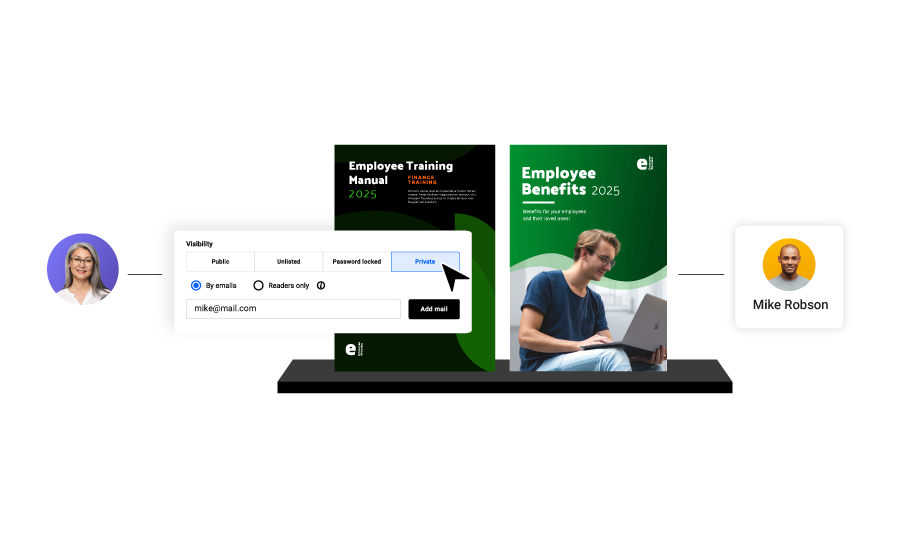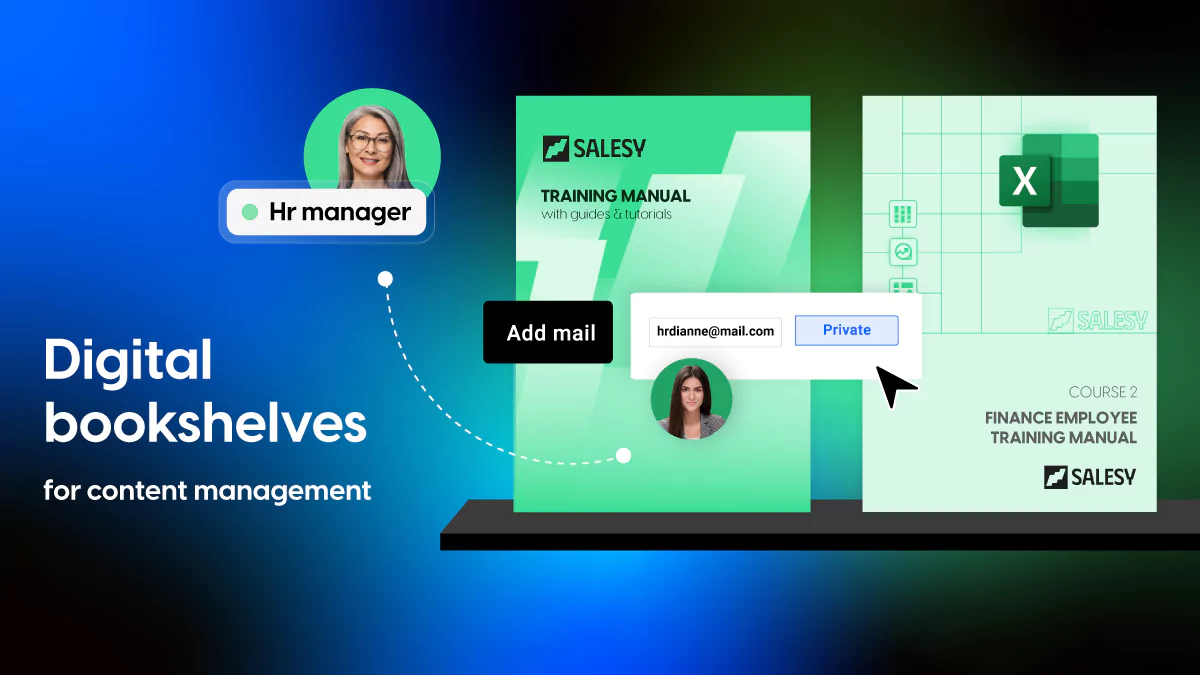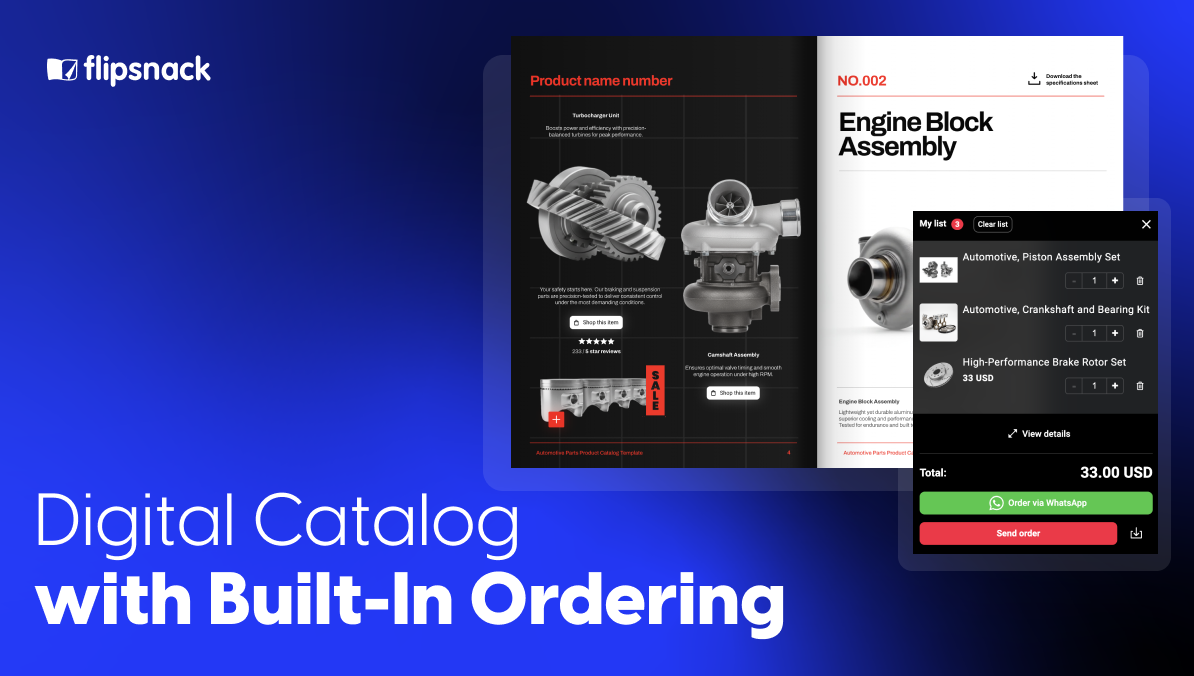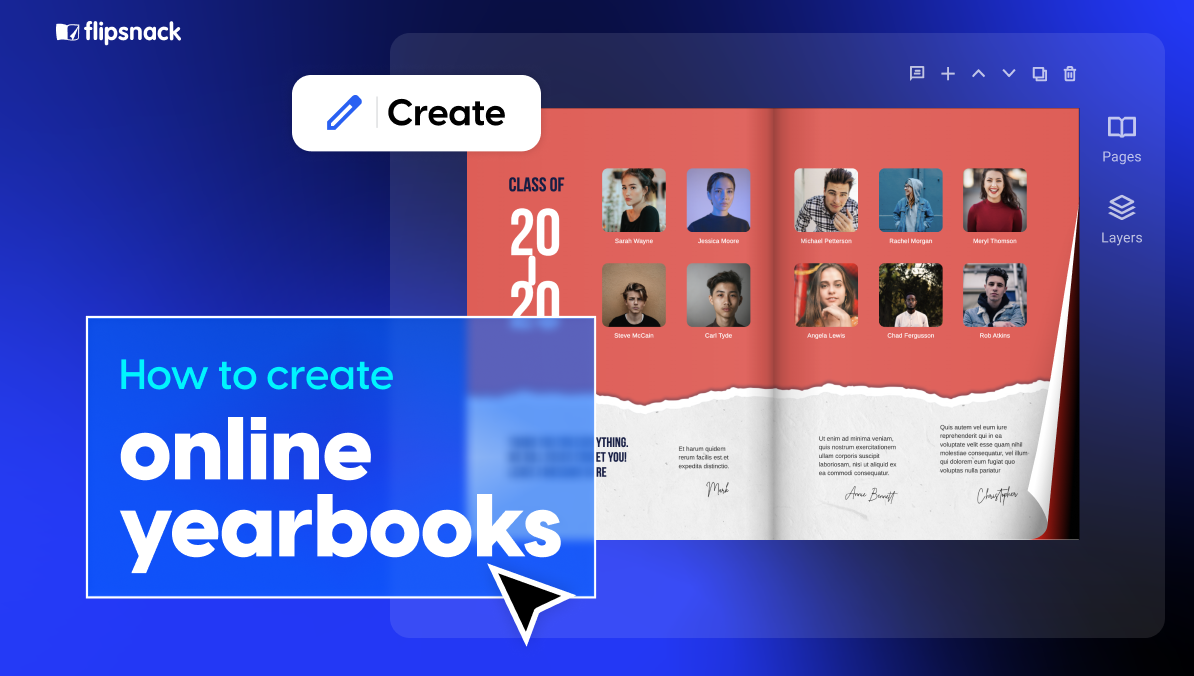Why Every Business Needs Digital Bookshelves For Content Management
Managing business content effectively isn’t just about storage. It’s about control, accessibility, and strategic impact. Whether you’re a sales leader struggling with scattered proposals, a training manager overseeing digital learning materials, or a marketing executive looking to streamline brand assets, disorganized content slows down workflows and creates inefficiencies.
That’s why Flipsnack’s digital bookshelves for content management are transforming how businesses operate. More than just a storage solution, a digital bookshelf centralizes content, streamlines workflows, provides up-to-date information, and provides actionable insights. All this while maintaining brand consistency with ease.
From retail and wholesale to real estate and hospitality, businesses leverage digital bookshelves to obtain smooth operation processes and structured content. If you’re ready to organize smarter, strengthen your brand identity, and track performance effortlessly, Flipsnack is your solution.
Let’s explore why every business needs a digital bookshelf for content management success.
Why leading companies rely on digital bookshelves
Managing content across multiple teams can be challenging without a centralized, organized, and trackable system. A digital bookshelf for content management helps businesses gain smooth workflows, ensure content security, and quickly enhance branding.
Here’s how different teams can benefit from Flipsnack’s digital bookshelf solution:
HR experts and training managers: Keep employees informed with up-to-date resources
Keeping employees informed of the latest updates is crucial for large businesses, especially when changes happen fast. With Flipsnack’s digital bookshelf, HR teams can update training materials, company policies, or internal documents in real time – without resending links or worrying about outdated versions.
Whether correcting a typo, refining important details, or rolling out new compliance guidelines, all it takes is a simple click on the Update button. Once clicked, the latest version is instantly available to everyone accessing the document within the bookshelves (and not only), ensuring teams always have the most accurate, up-to-date information at their fingertips. This eliminates version confusion, reduces unnecessary back-and-forth emails, and keeps your workforce aligned.

Marketing managers and retail teams: Categorize content and maintain brand consistency
For marketing and retail teams, maintaining brand consistency throughout their content can be challenging, especially when materials are shared with sales reps, distributors, customers, and partners. With Flipsnack’s digital bookshelf, businesses can create a centralized, customizable library where brochures, catalogs, and promotional materials are always accessible through a single branded URL.
Flipsnack’s custom branding options for digital bookshelves give marketers the flexibility to create a cohesive, professional look that aligns with their brand identity. They can customize the bookshelf URL, adjust the background, modify thumbnail sizes, and add the company logo to ensure every bookshelf reflects their corporate style.
For retail teams looking to bridge the gap between content and commerce, Flipsnack offers built-in shopping list functionality, making it easier for customers and sales reps to compile and act on product selections. Instead of juggling multiple PDFs and outdated versions, teams can organize content into segmented bookshelves for different product categories, including skincare, makeup, apparel, or accessories.
With intelligent search and categorization features, finding the right product brochure or pricing guide will take seconds for your customers. To take things even further. Retailers can embed the virtual on their website and offer a “second webpage” where customers can easily search for their favorite products and even place orders within the digital bookshelf.
By adopting a digital bookshelf for content management, marketing, and retail teams can enhance brand presentation and improve customer engagement.

Sales and real estate agents: Ensure proposals stay organized, secure, and trackable
Closing deals depends on delivering the right proposal at the right time, but version control issues, scattered files, and lack of visibility can slow down the sales process. With Flipsnack’s digital bookshelves for content management, sales teams can securely store, share, and track proposals while ensuring every stakeholder can access the latest version.
With permission-based access, teams can control who can view, edit, or manage proposals, reducing errors and maintaining confidentiality. Flipsnack’s statistics provide valuable insights into which proposals are being read, how long prospects engage with them, and where improvements are needed, helping sales reps fine-tune their approach.
This will also help to analyze the bookshelf’s performance and see which one performs better and how to optimize the others based on concrete data.
For a more personalized sales experience, businesses can equip each sales agent with a custom bookshelf tailored to specific clients, industries, or regions, ensuring they always have the most relevant and impactful sales materials at their fingertips.
The challenges of content management without digital bookshelves
Managing business content without a structured system creates clutter, inefficiencies, and lost opportunities. Let’s explore some traditional storage methods companies used before switching to Flipsnack’s powerful digital bookshelf. I’ll also feature real examples from our clients.
Companies relying on traditional storage methods often faced the following:
- Scattered documents & difficulty in retrieval – A leading e-learning provider struggled to keep training materials organized, making it hard for employees to find up-to-date resources.
- Limited collaboration – A manufacturing company faced version control issues with sales proposals, leading to multiple outdated files circulating internally and externally.
- Lack of access control – A global beauty brand needed to manage different digital brochures for product categories (makeup, skincare, fragrance) but could not assign permissions for internal teams vs. external partners.
- No performance tracking – A fashion retailer wanted to measure how employees engaged with interactive training materials but had no insight into which content was being used effectively.
Without a centralized, intelligent content system, businesses waste time, lose visibility, and risk inconsistency. A digital bookshelf solves these challenges by offering structured organization, controlled collaboration, and actionable insights.
How to implement digital bookshelves in content management systems
Implementing digital bookshelves within your content management system (CMS) can revolutionize how your organization handles and disseminates information. Flipsnack offers a comprehensive solution to streamline this process, enhancing efficiency and collaboration across your teams.
Step 1: Define your content categories
Start by uploading your PDF documents into Flipsnacks’ flipbook software and transform them into HTML5 digital publications. Then, customize them, add interactive elements to increase engagement, and easily add them to a category of bookshelf.
Flipsnack enables HR managers, sales, and marketing teams to create dedicated folders and collections in their bookshelves, ensuring that each piece of content is easily accessible and systematically arranged.
So, organize your digital bookshelf’s content into specific categories, such as bookshelves for employee training materials, business proposals, product catalogs, or brochures. Easily name each bookshelf to reflect the digital content you’ll add inside it, and the first step is done. This structured approach simplifies navigation and retrieval for all users.
After all digital materials are categorized, simply share the virtual bookshelf’s link by sending it via email to employees, customers, or prospects. Use Flipsnack’s public sharing options or select the private options – depending on your business needs.
Share the virtual bookshelf via link, email, social media, as a QR code, or even embedded on your company’s website for easy access.
Step 2: Set access permissions & collaboration levels
Maintaining control over who can view or edit content within the bookshelf is crucial. Flipsnack offers extensive collaboration settings, allowing you to assign roles like editors, viewers, and administrators. Increase productivity in your company with better organization by also creating dedicated workspaces for each department and team. Keep projects structured in their own centralized environments and make content management efficient, organized, and easily accessible across your business.
To ensure that confidential digital documents within a certain bookshelf are only accessible by authorized members, we encourage clients to try Flipsnack’s SSO integration. Users will experience secure and seamless access, enhancing collaboration while safeguarding sensitive information.

Step 3: Integrate bookshelves with existing tools
To ensure a cohesive workflow, it’s essential that your digital bookshelf integrates smoothly with existing tools. Flipsnack supports integration with various CRMs, CMS platforms, and cloud storage services, creating a unified content ecosystem. This connectivity allows for efficient content updates and consistent information across all platforms.
Imagine your marketing team wants to generate more MQLs from their digital bookshelf filled with ebooks. With Flipsnack’s lead form feature, they can seamlessly collect prospect information directly within their digital ebooks. Once shared, all captured data can be instantly transferred to their CRM using Flipsnack’s Zapier integration.
This ensures that every ebook from that bookshelf becomes a valuable conversion tool, helping marketers capture, organize, and act on leads more efficiently.
Step 4: Customize & brand your digital library
As previously discussed, brand consistency is key in all organizational materials. Flipsnack provides extensive branding options, enabling you to tailor your digital bookshelf with brand colors, logos, thumbnails, and names. This personalization ensures that your content library reflects your corporate identity, offering a professional appearance to both internal and external stakeholders.
Don’t forget that your digital bookshelf’s link can be fully branded and easily shared via Flipsnack’s diverse sharing options.
Step 6: Track digital bookshelves’ content engagement & optimize
Understanding how users engage with your content is essential for refining your strategy and maximizing impact. With Flipsnack’s bookshelf statistics, you gain detailed insights into both overall bookshelf performance and the individual flipbooks within it. Track key metrics such as views, average time spent, and interaction rates to identify successful materials and areas needing enhancement.
With detailed analytics, your internal communication experts can quickly gain a clear understanding of how each flipbook is performing within the bookshelf. Help them identify high-impact content, track audience interactions, and refine your strategy to ensure your materials resonate, convert, and drive results.
Also, take a look at this video and learn how to use and how to create, share, and track digital bookshelves.
Benefits of using digital bookshelves for organizational knowledge
A digital bookshelf isn’t just about storing files. It’s about creating a structured, accessible, and trackable content hub that improves efficiency across teams. Whether you’re handling sales proposals, interactive brochures, training materials, or marketing assets, a centralized system transforms how businesses manage content.
For sales and proposal teams, having a single, organized space for proposals eliminates confusion over outdated versions. No more scattered files. Teams can collaborate, apply permission controls, and track who accessed the document and when.
Training and HR managers benefit from a well-structured content library that ensures employees can always access the latest learning materials. With content tracking, they can see which resources are being used and adjust training strategies accordingly.

Digital bookshelves for content management keep brand assets consistent and interactive materials engaging. A beauty brand, for example, structured its digital library into separate categories for makeup, skincare, and fragrance brochures. This makes content easier to manage while improving the customer experience.
Here are the benefits of using digital bookshelves for content management:
- Centralized storage: Keep all essential digital documents in one accessible place.
- Advanced search: Categorization for faster content discovery.
- Enhanced collaboration: Teams can edit, share, and track real-time content.
- Secure sharing & permission settings: Set visibility & access levels for teams or external partners.
- Mobile accessibility: Ensure seamless access on any device, allowing teams, partners, or clients to view materials on the go.
- Custom URL sharing: Share digital bookshelves with a single branded link to easily maintain a professional presentation.
- Performance insights: Track who reads what and measure engagement levels for your digital materials within each bookshelf.
With search functionality, real-time analytics, and seamless sharing, businesses can transform disorganized content into a strategic asset. One that drives efficiency, collaboration, and measurable engagement.
The future of content management starts with digital bookshelves
Businesses today generate vast amounts of content but without a structured system. Digital bookshelves for content management help prevent valuable materials from becoming scattered. As discussed, a digital bookshelf provides a centralized, accessible, and trackable solution. It helps teams to store, share, and optimize content effortlessly.

With Flipsnack’s digital bookshelves, companies can take control of their content strategy, maintain brand consistency, and make informed decisions based on real-time data. If you’re ready to optimize content management, enhance collaboration, and drive better results, it’s time to explore the power of Flipsnack’s digital bookshelf.



